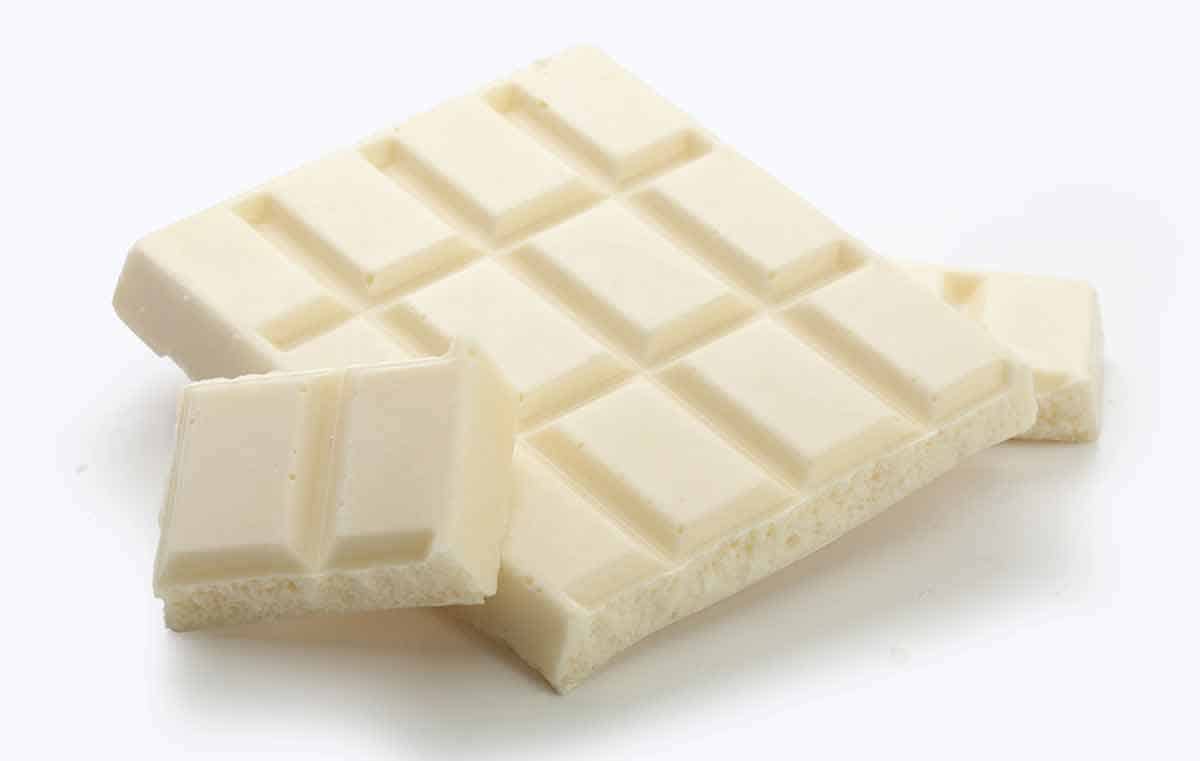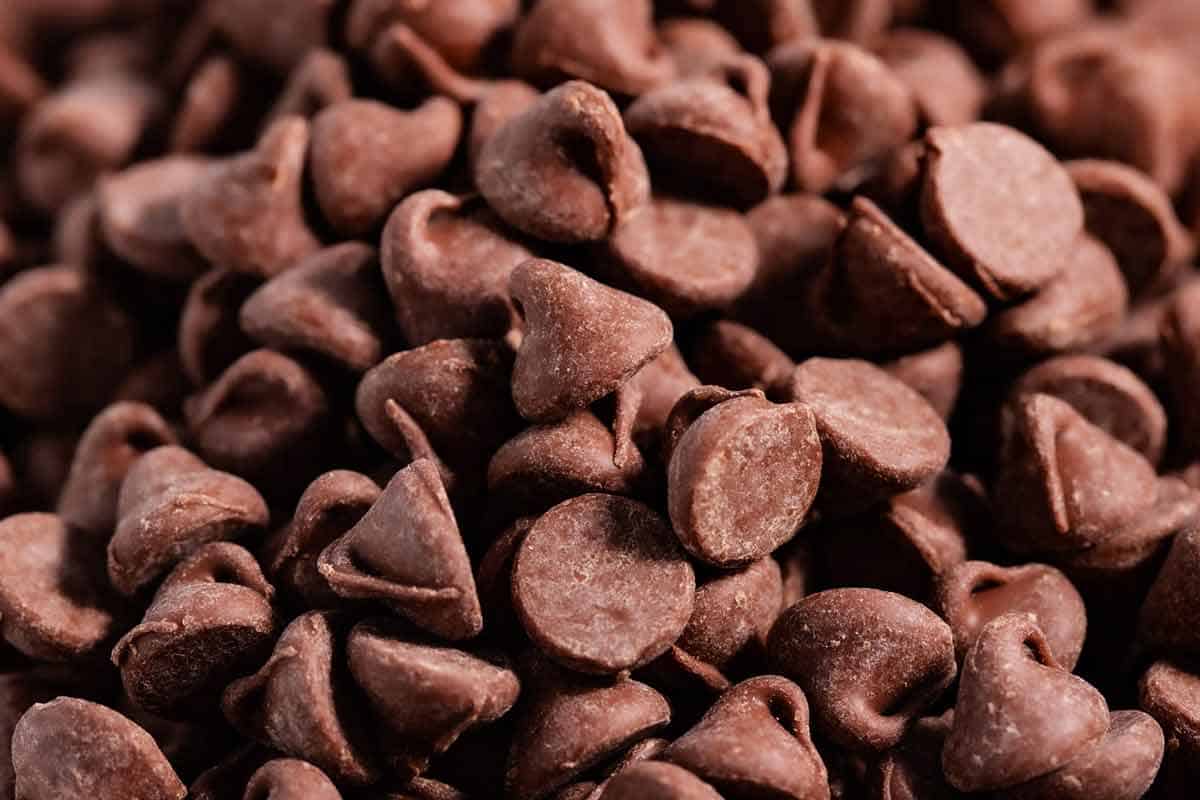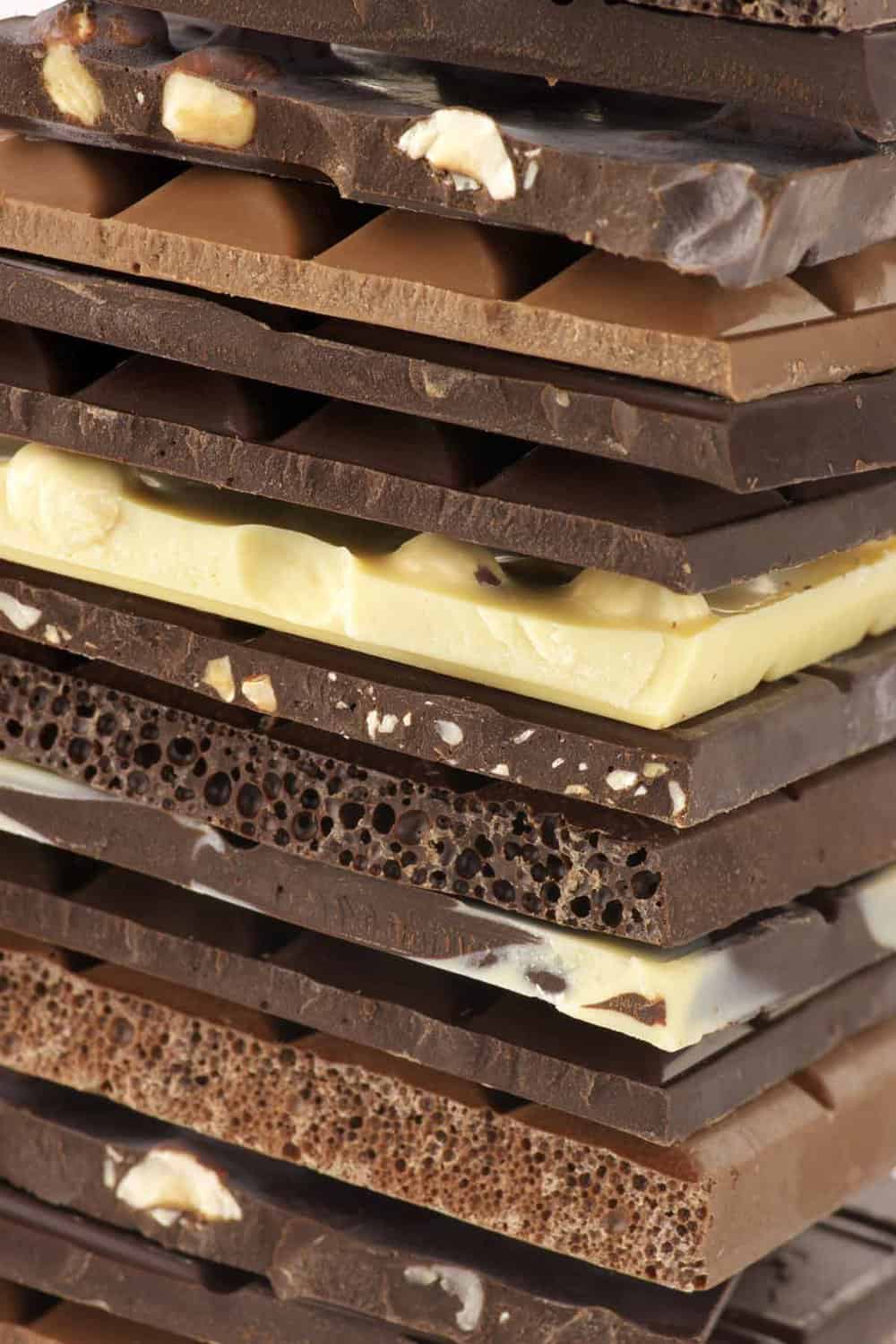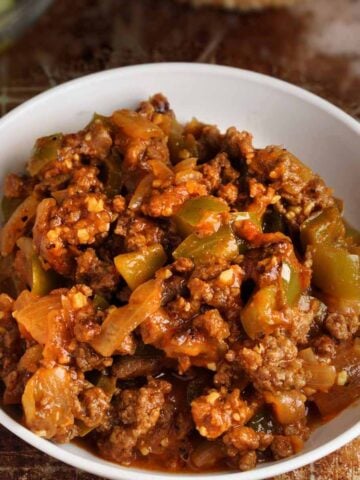Get all the sweet facts comparing white chocolate vs. milk chocolate. Contrast the taste, texture, pairings, and best uses. Learn how to easily identify chocolate quality.

“I never met a chocolate I could not eat,” said author Danielle Steele. Uh, yes!
You will be hard-pressed to find anyone who does not share her sentiments. You know chocolate tastes great! You love to eat it. But there is also much to learn from it.
How do white and milk chocolate compare? White chocolate is made from cocoa butter, milk, and sugar. It has no cocoa solids or powder, so it is a creamy pale color.
Milk chocolate is make from cocoa liquor, cocoa butter, milk, and sugar. The combination of cocoa and milk give this chocolate a light brown color.
RELATED: Check out the best substitutions for white chocolate.
Jump to:
- What is the Most Popular Type of Chocolate?
- Origin of All Chocolate
- White Chocolate vs. Milk Chocolate Taste Showdown
- What is the Official Definition of White vs. Milk Chocolate?
- Key White Chocolate vs. Milk Chocolate Ingredient Differences
- Nutritional Value of White vs. Milk Chocolate
- Are There Really Health Benefits From Eating Chocolate?
- Different Kinds of Chocolate
- All the Ways You Can Get Chocolate
- The Best White Chocolate vs. Milk Chocolate Uses in Your Recipe?
- How to Identify the Quality of Chocolate
- Most Popular Chocolate Brands
- Luxury Chocolate Brands
- White Chocolate vs. Milk Chocolate Shelf Life and Storage
- Final Chocolatey Thoughts
- Hungry for More Chocolate?
- Get Your Chocolate Education
- Comments
What is the Most Popular Type of Chocolate?

Let's start with the white chocolate vs. milk chocolate popularity contest.
Every chocolate poll reveals the same fact. Milk chocolate is the most loved chocolate, and white chocolate is the least preferred by consumers.
About 49% of the United States population claims milk chocolate as their favorite, while only 11% prefer white chocolate.
Darker chocolates are favored by 34% of people.
Whether you are a white chocolate fan or you crave milk chocolate, each has its place on the dessert table.
Origin of All Chocolate
In Greek, Theobroma cacao means “food of the gods." Chocolate lovers agree!
You may know that chocolate comes from cacao beans. But did you know it comes from a fruit tree known as Theobroma cacao? This tropical tree is native to South America in the Amazon and Orinoco River basins.

Cacao trees bear fruit similar in shape and size to papaya. One tree can produce about 2,500 beans. Good thing because it takes four hundred beans to make one pound of chocolate.
Because machines can harm the tree, the cacao seeds must be harvested by hand. When pods ripen and turn orange, the seeds are removed and transferred into fermentation trays which are covered with banana leaves.

They are left for up to a week to ferment. The fermentation process produces the chocolate flavor and aroma you love.
After fermenting, the beans are dried, cleaned, and roasted, drawing out the flavoring. Another machine cracks the beans and removes the hulls. These broken hulls are cacao nibs.
The tiny nibs are finely ground into solid cocoa mass. This mass is also known as chocolate liquor, although it contains no alcohol.

The cocoa liquor is placed under high pressure, which causes it to separate into cocoa powder and cocoa butter.
Cocoa bean powder, also known as chocolate solids or cacao solids, gives chocolate the chocolate taste.

A this point, the white chocolate vs. milk chocolate production changes. Only cocoa butter, milk powder, and sugar combine to make white chocolate. Never cocoa liquid.
On the other hand, milk chocolate is a mixture of cocoa butter, cocoa powder, milk powder, and sugar. Milk chocolate companies have their own formula for the amount of cacao in their recipe.
White Chocolate vs. Milk Chocolate Taste Showdown
White and milk chocolate taste entirely different from each other.

Taste of White Chocolate
Real white chocolate has a smooth, creamy texture. It has a sweet light buttery flavor, often with a subtle vanilla scent. It does not have the classic chocolate taste.
The cacao butter colors white chocolate pale yellow.
White chocolate pairs well with the taste of most fruits, especially blackberries, blueberries, lemon, and lime. It also combines deliciously with macadamia nuts and cashews.
Taste of Milk Chocolate

Milk chocolate has the rich flavor of chocolate. The addition of milk powder gives it a creamier feel and eliminates the bitter taste of dark chocolate.
Milk chocolate pairs well with walnuts, hazelnuts, and pecans. In addition, you will find it served alongside Gruyère and Asiago cheese. Or matched with coconut, orange, apples, cherries, peanut butter, honey, and caramel.
What is the Official Definition of White vs. Milk Chocolate?
The regulation of chocolate did not always exist. Only now do we have a formal classification of each.
White Chocolate

White chocolate emerged during World War I. Nestle had excess milk powder and did not want to waste it. So, milk powder was combined with cocoa butter. The result was the Milkybar – the first white chocolate bar.
White chocolate tasted similar to candy coating (made with cheap oils). Consumers had difficulty distinguishing between real white chocolate and an inexpensive knock-off. Especially if both products were called white chocolate.
In 2004, that changed when the United States Food and Drug Administration (FDA) intervened.
The FDA does not consider white chocolate to be real chocolate because of the absence of cocoa solids and powder. Instead, it labels the sweet a chocolate imitation or a confectionary. Only milk, sugar, and cocoa butter comprise the ingredients list.
The FDA established a standard of identity for white chocolate. It must contain at least 20% cocoa butter, at least 14% total milk solids, and at least 3.5% milkfat. Furthermore, it cannot have more than 55% sugar.
This definition means that if no cocoa butter is in the product, it is not real white chocolate. Check your labels, and you will never be fooled by a white lie (fake white chocolate).
Milk Chocolate

Milk chocolate contains powdered milk and dairy fat. It is made from cocoa butter, cocoa liquor, milk, and sugar.
Milk chocolate has a creamy consistency and a lot more sugar than dark chocolate.
The cocoa liquor gives chocolate a dark brown color. In contrast, milk products give milk chocolate the classic lighter brown color.
According to the FDA definition, milk chocolate must contain 10% chocolate liquor, 3.39% milkfat, and 12% milk solids.
Key White Chocolate vs. Milk Chocolate Ingredient Differences
According to the FDA white chocolate vs. milk chocolate definitions:
- White chocolate is required to have a higher (but very similar) percentage of milk products than milk chocolate.
- Cocoa butter is optional in milk chocolate, but required in white chocolate.
- Sugar (carbohydrate sweetener) is optional in both white and milk chocolate. However, the amount added is limited in white chocolate
- Cocoa liquor is required in milk chocolate and banned in white chocolate.
Nutritional Value of White vs. Milk Chocolate

Nutrition information from the U.S. Department of Agriculture (USDA) shows the differences in white chocolate vs. milk chocolate.
- A one-ounce serving of white chocolate has 153 calories, 9 grams of fat, 17 grams of carbohydrates (all from sugar), and 56 milligrams of calcium.
- A one-ounce serving of milk chocolate contains 153 calories, 8 grams of fat, 17 grams of carbs, 54 milligrams of calcium, and 0.7 milligrams of iron.
Are There Really Health Benefits From Eating Chocolate?

You wish the fantasy was true. Eat chocolate, get healthy.
It makes a punchy headline, but what are the facts?
Most credible research showing the health benefits of chocolate is conducted using the flavonoids found in cocoa powder, NOT A CHOCOLATE BAR.
Let me repeat that. The chocolate health benefits touted by chocolate companies are not based on eating a chocolate bar.
Instead, isolated flavonoids found in cocoa powder are usually the research subject. And that is where all the good news comes from.
The high level of antioxidants in flavonoids can improve blood flow, lower blood pressure, and increase insulin sensitivity.
These benefits aren’t found in milk or white chocolate but in the flavonoids in dark chocolate. Read more in the post white chocolate vs. dark chocolate.
However, you have probably experienced an improvement in mood after eating a fine piece of chocolate. These feel-good moments are real, but like all things… moderation is the key to avoid excess weight gain.
Different Kinds of Chocolate

- Regular chocolate comes as unsweetened, dark, semi-sweet, or milk chocolate. Each manufacturer uses different combinations of the cocoa solids and sugar to make their own recipe.
Good quality chocolates will list the percentage of cocoa in their product. The higher the percentage, the more cocoa. And often, the less sweet and more bitter it is.
- Pure white chocolate can sometimes be hard to find. There are many imitators. At times chocolate companies appear to trick the consumer while still following the letter of the law.
Imitation white chocolate products often have cheap oils instead of cocoa butter. And always lots of added sugar. These products will be very sweet.
They go by the names of white morsels, white chips, almond bark, and white melting wafers. They have their place in the culinary world, but they are not real white chocolate.
Read more on almond bark vs. white chocolate and candy melts vs. white chocolate.
- Ruby chocolate is the newest chocolate innovation. We can thank the Swiss chocolate company, Barry Callebaut, for the ruby variety.
The taste, color, and uniqueness of ruby chocolate result from the cacao bean variety and the fermentation procedure. The production method is a proprietary process kept as secretive as any formula in the industry.

All the Ways You Can Get Chocolate
Chocolate comes in many shapes and forms, including chips, bars, powder, pistoles, feves, and blocks. Powder is the only form you won’t find white chocolate in.
- Chocolate chips look like tiny droplets and are used primarily in baking. The soy lecithin in the chips helps them keep their shape during baking.
The chips come in mini, regular, jumbo, and chunks. An abundance of white chocolate chip imitators exists and many are ideal for baking. Learn how to measure any type of chocolate chips correctly for baking.

- Chocolate bars are typically found at your local grocery store, and they come in many sizes. Look for white or milk craft chocolate bars with delicious add-ins to transform your chocolate eating experience.

- Chocolate pistoles, or wafers, are flattened dollops of chocolate. This form is convenient for melting and is perfect for making ganache, glaze, pudding, or frosting.

- Chocolate feves are pieces of chocolate that mimic a cocoa bean and are a signature of the brand Valrhona. They are oval discs with an indented middle. This form of chocolate is good for melting.
- Chocolate blocks are thick bars of chocolate that must be chopped by hand. They are suitable for melting and are used in baking.
- Cocoa powder (the powder form of chocolate) has a flour-like feel and is ideal for use in cakes, brownies, ice cream, and drinks.
You won’t find real white chocolate in powder form. However, there is “white chocolate flavored” powder.
The Best White Chocolate vs. Milk Chocolate Uses in Your Recipe?
Chocolate can be used in a host of recipes, including cookies, candies, cakes, and chocolate fountains. But which chocolate should be used and when?

- For a chocolate fountain, Belgian chocolate is a top choice. It melts easily at a low temperature, keeping the sugar it contains from burning.
Use white or milk chocolate, but always make sure it is high quality. Otherwise, your chocolate fountain can get clogged.
- For melting, choose a chocolate that contains 32% or higher cocoa butter. While all chocolate melts, it will not all melt the same way. Chocolate with low cocoa butter loses its sheen. It may look chalky after cooling and solidifying again.
White chocolate melts at a lower temperature than milk chocolate, so watch it closely.

- To make ganache, use a pure chocolate baking bar, such as Bakers or Ghirardelli brands. Chocolate chips are not suitable for ganache because they will not melt into a good consistency.
Milk chocolate is better suited for ganache, but white chocolate ganache can be made too. Only use superior quality chocolate.

- For baking, any type of chocolate can be used. Even imitation white chocolate, which is candy.
- Frederick Aquino, executive pastry chef of Veranda in NYC, makes boiled chocolate frosting with cocoa powder for his devil’s food cake. But melted chocolate makes a great frosting too.
- For drizzling, coating, and decorating, white chocolate shines. As do white chocolate substitutes, which are easier to work with than the real thing. You can use milk chocolate too.

How to Identify the Quality of Chocolate
The way to tell the quality of white chocolate vs. milk chocolate is the same. Use your senses to judge whether your chocolate is exquisite or cheap. Listen, look, smell, and taste.

Listen
When you break your chocolate bar, do you hear a clean, crisp, sharp snap? Or did it bend and crumble, producing a dull sound?
The snap of breaking chocolate is one of the best ways to determine the chocolate quality. If the snap is crisp, you know three things.
- The chocolate contains a high percentage of cocoa butter.
- The chocolate was appropriately tempered.
- The chocolate has been stored correctly.
Look
Observe the chocolate. Is it smooth, shiny, and clear?
High-quality chocolate has a flawless appearance. No white or grey streaks. These lines are fat or sugar bloom, both indications of improper storage.
Check the ingredients label. Do you recognize the ingredients? Avoid chocolate with cheap oils, like palm oil. Or extra ingredients like soy lecithin, whey powder, or artificial sweeteners.
These ingredients may be trying to mask low-quality ingredients.
However, organic or specialty ingredients can indicate craft chocolate at its finest.
Smell
What does your chocolate smell like? Do you smell a rich, chocolatey scent? That is what you are after.
Even chocolate with a strong vanilla scent is the wrong choice. Too much vanilla raises my suspicions that something about the chocolate is being hidden.
Taste
High-quality chocolate contains a large percentage of cocoa butter. At least 20%, but higher is even better. Cocoa butter is responsible for the smooth, creamy mouthfeel you experience when eating chocolate.
If you feel a gritty or waxy texture, run away from that low-quality chocolate.
Also, because cocoa butter melts at body temperature, quality chocolate melts quickly in your mouth.
Most Popular Chocolate Brands
The majority of people who eat, eat chocolate. In fact, 90% of consumers enjoy mainstream chocolate, 70% premium, and 27% consume fine chocolate.

Some of the most popular everyday chocolate brands include Lindt, Ferraro Roche, and Hershey’s/Reese’s.
- Lindt has the highest quality chocolate and clean ingredients, making them the number one choice in chocolate.
- Ferraro Roche comes in second with superb ingredients, good taste and texture, and a sweet-nutty balance.
- Coming in third is Hershey’s/Reese’s because of the sweet flavor and smooth finish.
- Ghirardelli, with soft character, and Godiva, with its creaminess, round out the top five.

Luxury Chocolate Brands
There are also a growing number of specialty chocolate companies. Some of the top luxury chocolate brands include:
- Richart, a French chocolatier, won the Ruban Bleu award seven times. This is the most prestigious honor a chocolatier can receive. This is your best option for award-winning chocolate.
- The Patchi chocolate company in Lebanon is considered one of the best luxury chocolate brands in the world. They have over fifty different varieties of chocolate.
Their prices are high, but so is their quality. Choose this brand if you love trying out new chocolate tastes.
- French chocolatier, Valrhona, comes in third. Beans are sourced from South America and blended to provide a wide selection of flavors.
Cost is higher than everyday brands of chocolate but is comparable to other luxury brands. This is one of the chocolates preferred by top pastry chefs.
- Swiss chocolatier Teuscher created a name for himself when he set out to create chocolate that was preservative, chemical, and additive-free.
Using only the best ingredients, he created recipes for over one hundred varieties of chocolate. Consider these chocolates if you consume only the finest ingredients.
White Chocolate vs. Milk Chocolate Shelf Life and Storage
There is little chance of ever having leftover chocolate. However, we have all experienced the disappointment of finding that chocolate bar we forgot we had and realizing it is no longer fit to eat. Talk about a mood changer!
The best way to keep your chocolate ideal for eating is to ensure it is stored properly. Chocolate is best preserved if kept in a dark place at a cool room temperature.
Because it can pick up the odors of other food items, keep it in an air-tight container. This prevents odors from leeching into it. To store chocolate for a more extended period, wrap it and freeze it.
Let's compare white chocolate vs. milk chocolate vs. dark chocolate shelf life.
Not surprisingly, dark chocolate lasts longer than milk and white chocolate because it lacks dairy. Dark chocolate will last for about two years from the manufacture date if unopened and stowed properly. If opened and still stored appropriately, it will last one year.
For milk and white chocolate, the time is cut in half. These chocolates will last one year if unopened and stashed properly. But only 6-8 months if opened and suitably stored.
Final Chocolatey Thoughts
Chocolate is always a good answer to any question. White or milk, melted or solid, there is always room for chocolate. Someone once said, “Nine out of ten people like chocolate. [And] the tenth person always lies.”
Agreed!

Hungry for More Chocolate?
There are countless recipes with white and milk chocolate. Here are a few favorites.
- Hot cocoa with chocolate chips. Use milk or white chocolate chips to make hot chocolate in under two minutes. Quick and easy anytime you get the craving. Have you heard? It tastes great with fudge.
- Hershey chocolate chip cookies. My favorite way to make chocolate chip cookies is to chop up a Hershey chocolate bar. Try it once, and you will be hooked. Don't forget to store them right to stay fresh for longer.
- Chocolate chip cake. Bake an easy chocolate chip cake with cake mix and instant pudding. Easy, delicious, repeatable.
Get Your Chocolate Education
- Discover how many chocolate chips in a cup, in a tablespoon, or in an ounce.
- Learn the best way to melt chocolate chips on the stove or melt them in the microwave.
- Get the best methods for melting white chocolate chips, including how to melt white chocolate in the microwave.
Did you like this post? Then let's be social. FOLLOW ME on INSTAGRAM and PINTEREST to keep up with the latest happenings.






Comments
No Comments